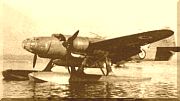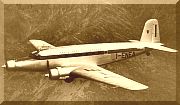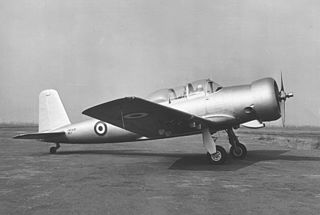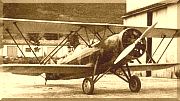
The Fiat BR.20 Cicogna was a low-wing twin-engine medium bomber that was developed and manufactured by Italian aircraft company Fiat. It holds the distinction of being the first all-metal Italian bomber to enter service; at the time, it was regarded as one of the most modern medium bombers in the world.

The Fiat G.50 Freccia ("Arrow") was a World War II Italian fighter aircraft developed and manufactured by aviation company Fiat. Upon entering service, the type became Italy’s first single-seat, all-metal monoplane that had an enclosed cockpit and retractable undercarriage. On 26 February 1937, the G.50 conducted its maiden flight. During early 1938, the Freccias served in the Regia Aeronautica and with its expeditionary arm, the Aviazione Legionaria, in Spain, where they compared well in speed and manoeuvrability with their adversaries in the theatre.

The Caproni Ca.133 was a three-engined transport/bomber aircraft used by the Italian Regia Aeronautica from the Second Italo-Abyssinian War until World War II.

The Savoia-Marchetti SM.75 Marsupiale was an Italian passenger and military transport aircraft of the 1930s and 1940s. It was a low-wing, trimotor monoplane of mixed metal and wood construction with a retractable tailwheel undercarriage. It was the last of a line of transport aeroplanes that Alessandro Marchetti began designing in the early 1930s. The SM.75 was fast, robust, capable of long-range flight and could carry up to 24 passengers for 1,000 miles.

The Fiat CR.20 was an Italian biplane fighter used during the 1920s and 1930s. Designed by Celestino Rosatelli, it represented an intermediate step from the early biplane CR.1 and the later, successful series CR.30, CR.32 and CR.42.
The Breda Ba.15 was a two-seat light aircraft produced in Italy in 1928.

The Caproni Ca.100 was the standard trainer aircraft of the Regia Aeronautica in the 1930s. Large numbers of this tandem, two-seat, biplane were built, powered by different engines.

The Fiat G.12 was an Italian transport aircraft of World War II.

The Fiat RS.14 was an Italian long-range maritime strategic reconnaissance floatplane. The RS.14 was a four/five seat all-metal cantilever low/mid-wing monoplane powered by two wing-mounted 626 kW (840 hp) Fiat A.74 R.C.38 engines. It had a conventional cantilever tail unit with a single fin and rudder. Its undercarriage consisted of two large floats on struts. It had a glazed nose for an observer or bomb aimer. The pilot and copilot sat side by side with a wireless operator's compartment behind them. In the bombing role the RS.14 was fitted with a long ventral gondola to carry various combinations of anti-submarine bombs.

The Piaggio P.148 was a 1950s Italian two-seat primary or aerobatic training monoplane designed and built by Piaggio Aero.

The Fiat G.212 was an Italian three-engine airliner of the 1940s. An enlarged development of Fiat's earlier G.12 transport, it was used in small numbers in commercial service and by the Italian Air Force.

The Fiat G.49 was an Italian two-seat basic trainer designed by Giuseppe Gabrielli and built by Fiat.

The Nardi FN.305 was an Italian fighter trainer and liaison monoplane developed by the Fratelli Nardi company.

The Fiat AS.1 was a light touring aircraft developed in Italy in the late 1920s.

The Fiat B.R. 1/4 was a light bomber series, developed in Italy shortly after World War I.

The Fiat G.46 was a military trainer developed in Italy shortly after World War II.

The Savoia-Marchetti S.59 was a 1920s Italian reconnaissance/bomber flying boat designed and built by Savoia-Marchetti for the Regia Aeronautica.

The SAIMAN 202 was a 1930s Italian two-seat cabin monoplane designed and built by the Società Industrie Meccaniche Aeronautiche Navali (SAIMAN).

The Macchi M.15 was an Italian reconnaissance aircraft, bomber and trainer, designed by Alessandro Tonini and Piero Bergonzi and built by Macchi.

The Caproni Ca.53 was an Italian prototype light bomber built in the last months of World War I.




















